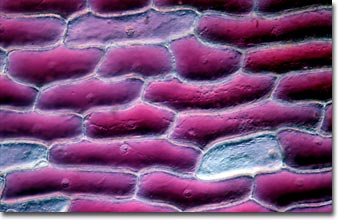Spike (M.I.) Walker
Onion Scale Epidermis
English photomicrographer Spike (M.I.) Walker has been a consistent winner of the Nikon Small World competition for many years and has published many articles and a book about microscopy. Featured below is a photomicrograph of a onion (Allium) bulb scale stripped epidermal layer.

|
A small section of onion (Allium) bulb scale epidermis, obtained from a scale leaf, was taken from a red variety of onion and its outer epidermis stripped and mounted in water and covered. Note the nuclei and red cell sap. The objective was a plan achromat 16x/0.35 NA using a 1.4 NA differential interference contrast (DIC) condenser. The microscope was a Zeiss Ultraphot III equipped with an automatic 35-millimeter photohead. The film was Fujichrome Velvia. (80x) |
Onions are among the world's oldest cultivated plants, and their pungent bulbs have probably been used in cooking since humans have been using fire. A member of the lily family, the onion is thought to be a native of Southwestern Asia but is now grown throughout the world. The common onion has one or more leafless stalks, terminating in a cluster of small greenish white flowers. The leaf bases of the developing plant swell to form the underground bulb that is the mature, edible onion.
The lily family comprises more than 250 genera and about 4,000 species of mostly herbaceous flowering plants, many with showy flowers. They are among the oldest cultivated plants, used by the ancient Greeks and Romans for medicinal purposes as well as prized garden ornamentals. The bulb of the Madonna lily was cultivated by cultures in Asia Minor for use in a ointment as early as the 2nd millennium BC. Other members of the lily family -- garlic, onions, chives, shallots, leeks, and asparagus -- are better known for their culinary applications and were used for food by prehistoric humans. The lily flower has held significance for various cultures over thousands of years, usually as a symbol of fertility and rebirth, but also as a symbol of innocence.
